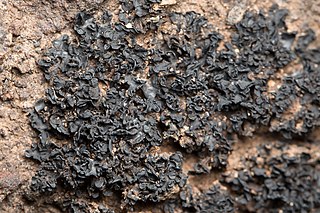
Lichinales is the sole order of ascomycete fungi in the class Lichinomycetes. It contains three families: Gloeoheppiaceae, Lichinaceae, and Peltulaceae. Most species are lichenized. Lichinales was proposed in 1986 by German lichenologists Aino Henssen and Burkhard Büdel. The class Lichinomycetes was created by Valérie Reeb, François Lutzoni and Claude Roux in 2004.
The Gloeoheppiaceae are a family of ascomycete fungi in the order Lichinales. There are seven species in the family. Most species are lichenized with cyanobacteria. Species in this family are mostly found in desert areas. The family was circumscribed in 1995 by German lichenologist Aino Henssen.

The Lichinaceae are a family of ascomycete fungi. Most species are lichenized with cyanobacteria, and have a distribution largely in temperate regions.

Ochrolechia is a genus of crustose lichens in the family Ochrolechiaceae.

Mazosia is a genus of lichen-forming fungi in the family Roccellaceae. The genus was circumscribed by Italian lichenologist Abramo Bartolommeo Massalongo in 1854.

Lempholemma is a genus of lichen-forming fungi in the family Lichinaceae.

Lichinella is a genus of lichen-forming fungi in the family Lichinaceae. It was circumscribed in 1872 by Finnish lichenologist William Nylander. Five species are accepted by Species Fungorum.
Lichinodium is a genus of filamentous lichens. It is the only genus in the family Lichinodiaceae, itself the only member of the order Lichinodiales. Lichinodium has four species. Previously considered part of the class Lichinomycetes, molecular phylogenetic analysis revealed that Lichinodium represents a unique lineage in the Leotiomycetes—the first known group of lichen-forming fungi in this class.

Peccania is a genus of lichenized fungi within the family Lichinaceae. As of July 2023, Species Fungorum accepts five species of Peccania, although many more species have been placed in the genus.
Psorotichia is a genus of lichen-forming fungi in the family Lichinaceae. The genus was circumscribed by Italian lichenologist Abramo Bartolommeo Massalongo in 1855, with Psorotichia murorum assigned as the type species.
Stromatella bermudana is a saxicolous (rock-dwelling) crustose lichen. It is the only species in Stromatella, a monotypic fungal genus in the family Lichinaceae. The genus was circumscribed in 1989 by German lichenologist Aino Henssen. This species was originally described as Psorotichia bermudana by US botanist Lincoln Ware Riddle in 1916, from specimens collected in Bermuda.
Zahlbrucknerella is a genus of filamentous, rock-dwelling lichens in the family Lichinaceae.

Peltula is a genus of small dark brown to olive or dark gray squamulose lichens that can be saxicolous ) or terricolous. Members of the genus are commonly called rock-olive lichens. They are cyanolichens, with the cyanobacterium photobiont from the genus Anacystis. They are umbilicate with flat to erect squamule lobes that attach from a central holdfast or cluster of rhizenes. Lichen spot tests are usually negative.
Sagiolechia is a genus of lichen-forming fungi in the family Sagiolechiaceae. The genus was circumscribed by lichenologist Abramo Bartolommeo Massalongo in 1854, who assigned Sagiolechia protuberans as the type species. The family Sagiolechiaceae was proposed in 2010 to contain Sagiolechia as the type genus, and genus Rhexophiale; molecular phylogenetic analysis showed that these two genera formed a distinct clade in the Ostropales.

Thamnolia is a genus of lichens in the family Icmadophilaceae. Members of the genus are commonly called whiteworm lichens.

Heppia is a genus of olive, brownish, gray, or blackish squamulose, crustose, or peltate like lichens. Heppia was once the type genus of the family Heppiaceae, but that family was folded into synonymy with Lichinaceae.

Massalongia is a genus of lichen-forming fungi in the family Massalongiaceae. It has four species. The genus was circumscribed by German lichenologist Gustav Wilhelm Körber in 1855, with M. carnosa assigned as the type species.

Solenopsora is a genus of lichen-forming fungi in the family Catillariaceae. It has 15 species, with a mostly Northern Hemisphere distribution.

Sporastatia is a genus of crustose lichens in the family Sporastatiaceae. It has four species. Sporastatia lichens are long-lived species that grow on siliceous or weakly calcareous rocks in arctic and alpine locales.
Harpidiaceae is a small family of lichen-forming fungi, containing two genera and five species. It is of uncertain classification in the Pezizomycotina.












